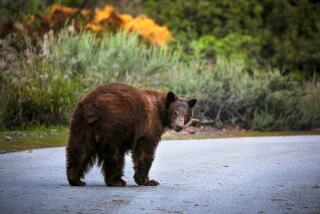Weather Is Rocking Boat for Crabbers in Northern California
- Share via
Poor weather along California’s northern coast has dampened the state’s Dungeness crab fishing industry and helped drive up the price of fresh crab 40%.
Stiff winds and pounding seas, along with small catches by those crabbers who dare to venture out, means a meager supply of crab meat for the first phase of California’s commercial crab fishing season, which began Nov. 15 and runs through mid-July.
After a good season two years ago and a mediocre one last year, many fishermen had hoped to take advantage of high demand for the early season catch before the price paid to fishermen settled down to the season’s norm of about $1.90 a pound.
But this year’s mediocre early season has helped push the retail price of fresh crab to as high as $6 a pound, said Zeke Grader, executive director of the Pacific Coast Federation of Fishermen’s Assns.
“In the winter, the weather changes so damned quickly; even when the forecast is good, you can still get caught,” said Steve Smith, who fishes a boat called Puffin off the coast of Half Moon Bay.
Most of Half Moon Bay’s 25-odd crab boats spent valuable days stuck at the docks about 30 miles south of San Francisco, passing on a chance at big profits from one of the nation’s most dangerous professions.
“Only the crazy people are going out,” Smith said.
California’s haul usually represents about 20% of the Dungeness crabs pulled from the waters off the Pacific Coast--the only region in the United States where the crabs are found. The nearly 700 boats permitted in California landed almost 5,000 tons of crab last season, according to the state Fish and Game Commission.
On a good day, the crab boats motor out to where they’ve dropped 100-pound traps, or “pots,” to the ocean floor. Each pot, made of steel rods, rubber wrapping and chicken wire, is tied to a two-foot-long buoy with a length of durable nylon rope--the only visible sign from above of their existence below.
To retrieve the writhing, snapping Dungeness crabs inside, the skipper maneuvers the boat alongside the buoy and a crew member plucks it from the sea, then feeds the line into a hydraulic winch. Hauled up from the ocean floor, the crabs are sorted--females and small males are thrown back--and dumped into a holding tank. The pots, baited again with old fish, are tossed back into the sea.
It’s grueling, repetitive, cold and dangerous work. But in a good year, a small crab boat working steadily and blessed with some luck can gross $200,000 or more.
Commercial fishing is the country’s most dangerous profession, with a mortality rate of 62 deaths per 100,000 fishermen, according to the Bureau of Labor Statistics. The fatality rate for fishermen on the West Coast is almost double that.
And crabbers have the highest fatality rate in the fishing industry, said Rob Lee, fishing vessel coordinator at the Coast Guard’s Marine Safety Office in Alameda. In the last five years, 59 crabbers have died off the coasts of California, Oregon, Washington and Alaska.
“It’s one of the prime industries that happens in middle of winter when the weather is not at its best,” Lee said. “And we have cold water--once people go into the water, they don’t have long to live.”
California’s crab season has two opening days, the first in mid-November from Sonoma County south to Mexico, and the second Dec. 1 from Mendocino County north to the Oregon border.
However, this year the north coast’s opening was delayed until Dec. 11 because samples showed the crabs there still had soft shells, a sign that they hadn’t matured enough to eat.
That was good news for southern crabbers in an otherwise spotty season, keeping the overall catch down and driving up the price.
“I think the catch for our port overall is down about two-thirds,” said fisherman Walt Doll, who operates near Half Moon Bay south of San Francisco. “But for myself, I’ve caught more crab this year than I have in the past.”
Despite having turned only four trips due to inclement weather, Doll said he has hauled in about 4,700 pounds of crab--about 1,000 more pounds than last year at this time.
He attributes his success to a combination of luck and some good decisions about where to drop his pots--the precise locations of which are a jealously guarded secret.
The safety risks, hard work and start-up costs are driving away younger generations, leaving the average age of commercial crabbers at 45--like Smith.
“It takes years and years just to learn how to deal with it,” Smith said. “You can’t just buy a boat and point it toward the Pacific Ocean and expect to survive.”
More to Read
Sign up for The Wild
We’ll help you find the best places to hike, bike and run, as well as the perfect silent spots for meditation and yoga.
You may occasionally receive promotional content from the Los Angeles Times.






